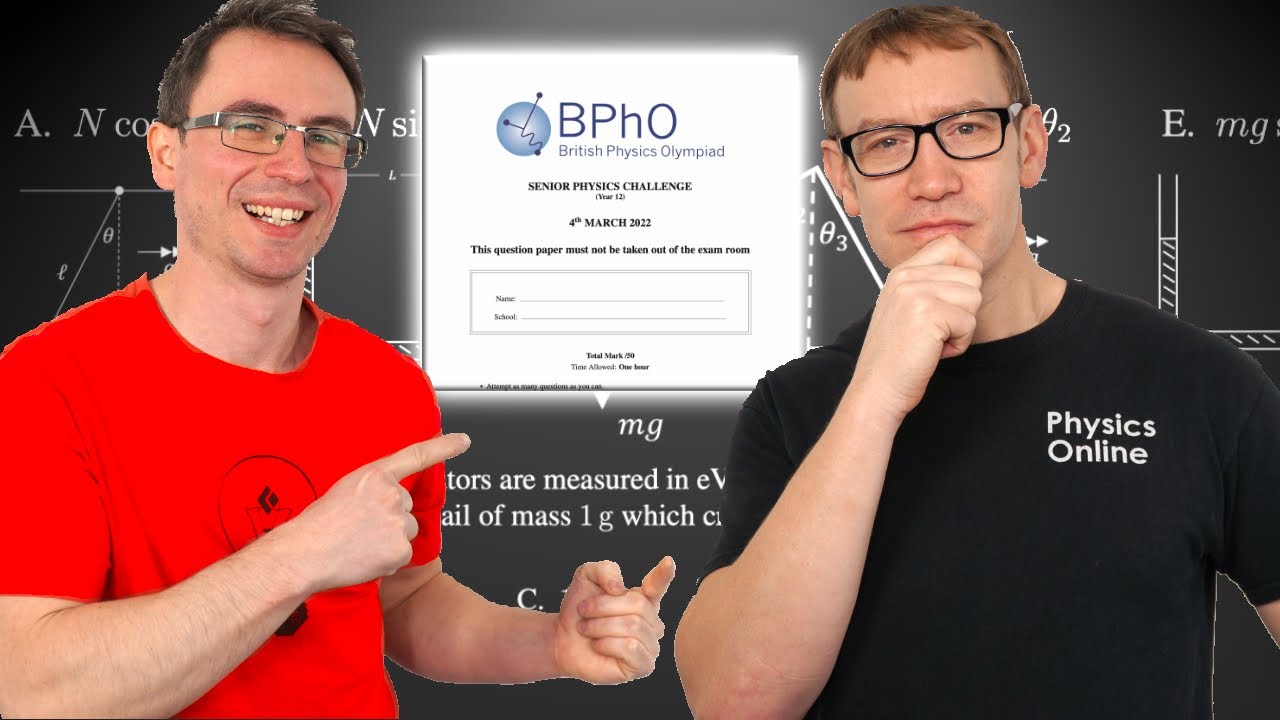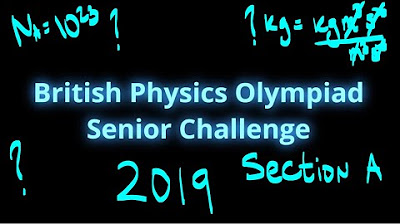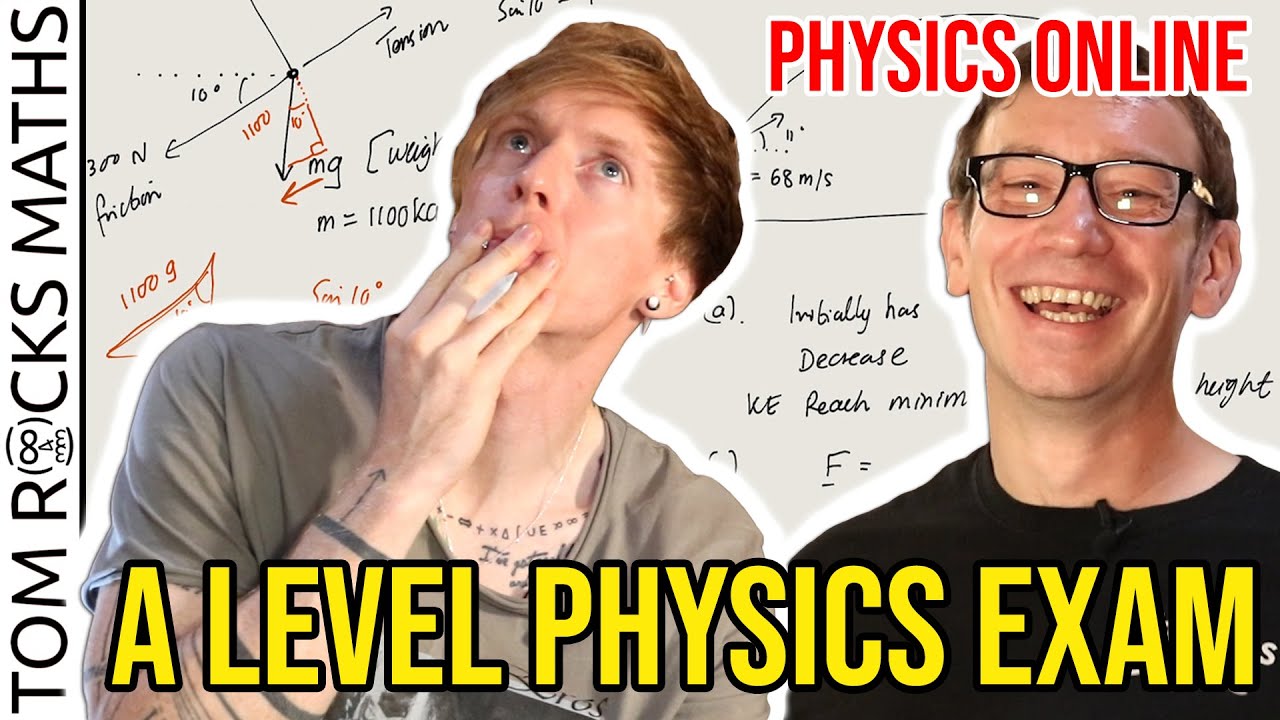A Level Physics Teachers Take On Olympiad Questions
TLDRIn this engaging video, the host is joined by Zed Physics to tackle challenging problems from the British Physics Olympiad. They explore a variety of physics concepts, starting with a rocket's changing mass and acceleration, then moving on to an airplane's speed and trajectory calculations. The duo also delves into a complex problem involving a rod balanced in a hemispherical bowl, discussing equilibrium, force resolution, and moments. The video emphasizes the importance of practice, problem-solving skills, and the relevance of physics to everyday phenomena, encouraging viewers to embrace the challenge and learn from the process.
Takeaways
- 🚀 The video discusses solving physics problems from the British Physics Olympiad, focusing on challenging questions that require a deep understanding of physics concepts.
- 📝 The first problem involves a rocket losing mass due to fuel consumption, which is an atypical scenario because mass is usually constant in physics problems.
- 🔢 The rocket problem uses Newton's Second Law to calculate thrust and acceleration, highlighting the importance of understanding how forces relate to changes in momentum.
- ⏱ The video emphasizes the importance of visualizing problems through diagrams and understanding the time-dependent nature of mass in the rocket's acceleration.
- 📉 The Olympiad problems are presented as a learning opportunity, with the host suggesting that the challenging nature of the problems can significantly enhance one's physics knowledge.
- 🛫 The second problem involves an airplane's movement and uses bearings and vectors to determine speed and future position, showcasing the application of trigonometry in physics.
- 📐 The video demonstrates the use of the cosine rule and the sine rule in solving geometry-related physics problems, such as the airplane's trajectory.
- 🔄 The hosts discuss the iterative process of problem-solving, emphasizing the value of perseverance and the learning experience even if a problem is not fully solved.
- 🥄 A third problem about a spoon and cereal ball is introduced to illustrate the balance of forces and moments in a static system, like a rod balanced in a bowl.
- 📚 The video concludes with a recommendation for students to engage with Olympiad problems to improve their physics skills and prepare for university-level studies.
- 🤝 The collaboration between the hosts provides a dynamic learning experience, with each host contributing different perspectives and insights into solving physics problems.
Q & A
What is the main topic discussed in the video?
-The main topic discussed in the video is solving physics problems, specifically from the British Physics Olympiad.
Why are rockets a common topic among physics teachers?
-Rockets are a common topic among physics teachers because they provide an engaging way to demonstrate principles such as Newton's Second Law and momentum change.
What is unique about the rocket problem discussed in the video?
-The unique aspect of the rocket problem discussed is that it involves a variable mass, as the rocket loses mass due to fuel consumption during acceleration.
How is Newton's Second Law applied in the context of the rocket problem?
-Newton's Second Law is applied by equating the force acting on the rocket to the rate of change of its momentum, taking into account the changing mass due to fuel expulsion.
What is the significance of drawing diagrams in physics problems?
-Drawing diagrams is significant in physics problems as it helps visualize the forces and relationships involved, and can also contribute to earning marks in exams like the Olympiad.
What is the role of trigonometric identities in solving complex physics problems?
-Trigonometric identities play a crucial role in solving complex physics problems by simplifying expressions and helping to derive relationships between different quantities, such as force, distance, and angles.
Why are Olympiad problems considered challenging yet rewarding?
-Olympiad problems are considered challenging due to their complexity and the depth of understanding required to solve them. They are rewarding because they provide a sense of achievement and significantly enhance one's problem-solving skills.
What is the purpose of the airplane bearing problem discussed in the video?
-The purpose of the airplane bearing problem is to demonstrate the application of vectors, trigonometry, and geometry in determining an object's speed and future position based on its observed movements.
How does the video script emphasize the importance of practice in learning physics?
-The video script emphasizes the importance of practice by suggesting that working through Olympiad problems, even if they are difficult, helps in reinforcing concepts and makes standard exam questions seem more straightforward.
What advice does the video give for students preparing for Olympiad exams?
-The video advises students to persevere with challenging problems, use diagrams and trigonometric identities effectively, and practice on Olympiad questions to improve their understanding and problem-solving skills.
Outlines
🚀 Introduction to Rocket Physics Problem
The video begins with the host introducing a challenging physics problem from the British Physics Olympiad. The focus is on a rocket with a mass of 5,000 kg that is losing mass due to fuel being expelled at a rate of 50 kg per second at 2,000 m/s. The unique aspect of this problem is the variable mass, which changes over time as the rocket ascends and uses up its fuel. The host is joined by Zed, who has a stronger grasp of physics concepts, particularly Newton's Second Law, which will be applied to find the thrust and acceleration of the rocket. The video aims to solve the problem step by step, starting with basic physics knowledge and building up to more complex calculations.
📚 Newton's Second Law Applied to Rocket Motion
In this segment, the host and Zed delve into the specifics of the rocket problem, starting with Newton's Second Law to calculate the thrust. They discuss the importance of diagrams in visualizing the forces at play and the significance of understanding the rate of change of momentum. The host explains that the force acting on the rocket is the result of the mass of the expelled fuel and its change in velocity. They calculate the thrust to be 100,000 N without even using a calculator, emphasizing the rewarding nature of solving physics problems. The conversation also touches on the educational value of engaging with challenging problems and the joy of arriving at the correct solution.
✍️ Deriving the Rocket's Acceleration Over Time
The discussion moves on to finding an expression for the rocket's acceleration as a function of time. The host explains that the mass of the rocket decreases linearly as fuel is lost at a constant rate. They derive an equation for the mass of the rocket as a function of time and then use it to express the acceleration. The units of acceleration are confirmed to be in meters per second squared, and the host and Zed agree that the derived expression is correct. The segment highlights the importance of careful calculation and the application of physics principles to real-world scenarios.
🧐 Calculating the Time for Apparent Weight Doubling
This part of the video tackles a complex question regarding the time after launch at which an astronaut on board the rocket would feel their weight has doubled. The host uses the previously derived acceleration expression and sets up an equation to solve for the time when the apparent gravitational force would be twice that of Earth's gravity. They rearrange the equation and plug in the values to find the time, which is calculated to be approximately 98 seconds. The host emphasizes the importance of perseverance and using resources like mark schemes when practicing for the Olympiad.
🛫 Solving the Airplane Bearing and Speed Problem
The host introduces a new problem involving an airplane's movement and the use of bearings and vectors. The problem requires determining the speed and future position of the plane based on its bearings and distances from an observer. The host suggests using a protractor for accuracy and emphasizes the importance of diagrams in solving such problems. They apply the cosine rule to find the distance the plane travels in five minutes and then calculate the speed of the aircraft to be 82 m/s. The host then extends the diagram to estimate the plane's position after ten minutes, highlighting the practical use of trigonometry and geometry in solving physics problems.
📐 Advanced Airplane Trajectory Calculation
The host continues to work through the airplane problem, focusing on the trigonometric aspects of the calculation. They use the sine and cosine rules to find unknown angles and distances within the triangle formed by the observer and the airplane's positions. The host calculates the final distance and bearing of the airplane after ten minutes, emphasizing the importance of accurate diagramming and the use of trigonometric identities. The solution process is shown to be iterative and detailed, with the host checking their work against the mark scheme for accuracy.
🔄 Complex Forces and Moments in Equilibrium
In this segment, the host and Zed tackle a complex problem involving a thin rod balanced in a hemispherical bowl. They discuss the forces acting on the rod, including normal forces and gravity, and how these forces are resolved into components. The host explains the importance of considering moments in equilibrium problems and sets up an equation based on the forces and distances involved. They work through the algebra and trigonometry to find an expression for the radius of the bowl in terms of the rod's length and the angle to the horizontal.
🎯 Final Steps to Solve the Bowl and Rod Equilibrium Problem
The host concludes the problem-solving session by finalizing the expression for the radius of the bowl in terms of the rod's length and the angle. They use trigonometric identities to simplify the equation and make the radius the subject of the equation. The host and Zed confirm the correctness of their solution by comparing it with the provided mark scheme. The segment wraps up with a discussion on the educational value of tackling complex problems and how they can enhance understanding and problem-solving skills in physics.
🤓 Reflections on the Olympiad Problem-Solving Process
In the final segment, the host reflects on the experience of solving Olympiad problems, emphasizing the benefits of engaging with challenging questions. They discuss how working through these problems can improve understanding and prepare students for university-level physics or engineering studies. The host thanks Zed for his contributions and invites viewers to explore more Olympiad problems and resources available on Zed's physics platform. The video ends with an encouragement for viewers to continue practicing and challenging themselves with complex physics problems.
Mindmap
Keywords
💡Newton's Second Law
💡Momentum
💡Thrust
💡Acceleration
💡Mass
💡British Physics Olympiad
💡Force Diagram
💡Bearing
💡Cosine Rule
💡Trigonometric Identities
Highlights
Introduction to solving challenging physics problems from the British Physics Olympiad 2022.
Discussion on the relevance of Newton's Second Law for a rocket with changing mass.
Explanation of calculating the thrust applied to a rocket using the change in mass and velocity.
Deriving the expression for the acceleration of the rocket in terms of its total mass.
Visualization tip: Importance of drawing diagrams for understanding forces and acceleration.
Calculating the acceleration of the rocket as a function of time considering fuel loss.
Detailed step-by-step process to derive the mass of the rocket as a function of time.
Application of the derived formulas to calculate the time when an astronaut's weight appears to double.
Use of trigonometric identities and geometric reasoning to solve problems involving rocket movement.
Real-world application: Analogy of the rocket problem to the physics of elevators.
Introduction to solving a plane's speed and bearing problem using the cosine rule.
Importance of drawing large, accurate diagrams and using tools like protractors for precision.
Step-by-step resolution of forces and moments in a problem involving a balanced rod in a hemispherical bowl.
Derivation of the relationship between the radius of the bowl and the length of the rod using trigonometry.
Conclusion highlighting the educational value of solving Olympiad problems for developing deeper physics understanding.
Transcripts
Browse More Related Video

Physics Youtubers VS Physics Olympiad

My Solutions to the British Physics Olympiad, BPhO Senior Challenge 2019 Multiple Choice

Here is a HARD Physics Olympiad Question - BPhO Round 1, Section 2 2020

My Solutions: British Physics Olympiad Round 1 2020 - Section 1 a to c

Can an Oxford University Mathematician solve a High School Physics Exam? (with @PhysicsOnline)

My Solutions to the British Physics Olympiad: BPhO Senior Challenge 2018 Multiple Choice
5.0 / 5 (0 votes)
Thanks for rating: